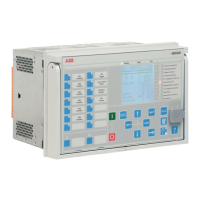Regulator pumping
It is possible that faulty settings cause the regulator to give control pulses too
frequently. For example, too low a setting for the
Band width voltage
(
Figure
559
) can result in a pumping condition where the regulator has problems to bring
the regulated voltage to a desired level. To detect this, OLATCC has a setting
Max operations in 1h
, which defines the allowed number of lowering and raising
commands during a one-hour sliding time window. The detection is active both in
the manual and automatic operation modes. The alarm is reset after the counted
number of the operations during the one-hour time window is less than the set
value. The number of executed operations per last one hour can be read from the
monitored data OP_TM_NUM_H. However, this parameter is updated only in three-
minute intervals. Again, the monitored data ALARM_REAS is set during an alarm.
This means that only if alarm reason is active, ALARM_REAS has the value "Pump
error".
The operation of OLATCC is not blocked during an alarm situation, but all the
alarms mentioned above cause the automatic operation to be delayed. In practice,
this means that the set delay times T1 and T2 are doubled.
In addition to the alarm detections, OLATCC provides a nonvolatile operation
counter parameter (monitored data OPR_CNT) for determining the service intervals
of the tap changer. The counter gives the total number of raising and lowering
commands given in the manual and automatic modes. All commands, even those
that are omitted by the tap changer due to its operation sequence, are calculated
in a cumulative counter. This data parameter can be reset via the clear menu
parameter
OLATCC counter
.
9.5.5 Application
OLATCC is used to control the voltage on the load side of the power transformer.
Based on the measured voltage and current, the function block determines whether
the voltage needs to be increased or decreased. The voltage is regulated by the
raising or lowering commands sent to the tap changer.
The basic principle for voltage regulation is that no regulation takes place as
long as the voltage stays within the bandwidth setting. The measured voltage is
always compared to the calculated control voltage U
p
. Once the measured voltage
deviates from the bandwidth, the delay time T1 starts. When the set delay time has
elapsed, a raising or lowering control pulse is sent to the tap changer. Should the
measured voltage still be outside the bandwidth after one tap change, the delay
time T2 starts. T2 is normally shorter than T1.
Under certain circumstances, the automatic voltage regulator needs to be
enhanced with additional functions such as Line Drop Compensation (LDC) and
Reduce Set Voltage (RSV). Also, various parallel operation modes are available to
fit applications where two or more power transformers are connected to the same
busbar at the same time. The parallel operation modes of OLATCC are Master/
Follower (M/F), Minimizing Circulating Current (MCC) and Negative Reactance
Principle (NRP).
1MRS757644 H
Control functions
620 series
Technical Manual
1067

